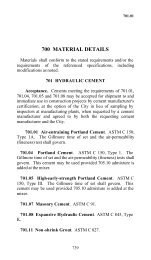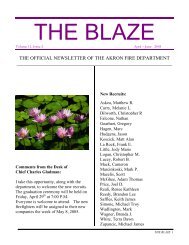Akron Water Pollution Control Station No Feasible Alternative
Akron Water Pollution Control Station No Feasible Alternative
Akron Water Pollution Control Station No Feasible Alternative
Create successful ePaper yourself
Turn your PDF publications into a flip-book with our unique Google optimized e-Paper software.
listed in Section 4.2.1. The 120 MGD alternative will be referred to as <strong>Alternative</strong> 1. Refer to<br />
Figure 4-1.<br />
A variety of other process alternatives were considered for increasing the secondary treatment<br />
capacity. These alternatives, upon initial screening, were organized into five groups. For any<br />
alternative which provides additional secondary treatment capacity, it is assumed existing<br />
facilities are upgraded to increase the 110 MGD capacity to 120 MGD.<br />
Group 1 <strong>Alternative</strong>s – Single Stage Nitrification Processes<br />
This group includes single stage nitrification processes, including oxidation ditches, vertical loop<br />
reactors, step-feed aeration, and high rate pure oxygen that may be employed either within<br />
existing tankage and/or in additional, new tankage. With this group of alternatives the primary<br />
settling tanks would be removed from service in order to increase the organic and nutrient<br />
loading to secondary treatment sufficiently to support additional mixed liquor capacity. Along<br />
with this increased capacity would come additional final settling tanks.<br />
These Group 1 alternatives are screened from further evaluation for the following reasons:<br />
• Having additional mixed liquor in suspension will increase annual operation and<br />
maintenance (O & M) costs for blower operation and yield no treatment improvement. The<br />
sludge settleability may actually deteriorate due to increased sludge retention times (SRTs)<br />
• Abandonment of the primary settling tanks will impact the existing sludge process train that<br />
includes a compost facility for final stabilization and disposal, and a planned anaerobic<br />
digestion process being initiated in 2007. A significant investment would be required to<br />
reconstruct the sludge process train to treat solely waste activated sludge. The sludge<br />
processing costs would be higher then the current cost for composting. And, final disposal<br />
costs will be significantly higher for land application as compared with the current compost,<br />
most of which is sold in bulk or bag to consumers.<br />
Group 2 <strong>Alternative</strong>s – Conventional and Attached Growth Processes<br />
Conventional activated sludge, contact stabilization, rotating biological contactors (RBCs),<br />
Submerged Biological Contactors (SBCs), and trickling filters are included in this group. All<br />
Group 2 alternatives require the primary settling tanks remain in service to reduce the organic<br />
and nutrient loading; and, they have shorter hydraulic detention times and shorter SRTs. The<br />
sludge produced is typically more settleable as supported by the Recommended Standards For<br />
Wastewater Works 2 (Ten States Standards) which allows higher surface overflow rates (SOR)<br />
and peak solids loading rates for settling tanks following these processes. The existing final<br />
settling tanks, in theory, could process higher peak flows up to approximately 170 MGD based<br />
on these SORs.<br />
The major problem for the Group 2 alternatives is that sufficient nitrification will not occur with<br />
these processes to achieve ammonia nitrogen levels meeting the City’s NPDES Permit. There<br />
are also other unacceptable aspects of these alternatives. First, effluent CBOD5 concentrations<br />
would also likely be higher than currently achieved with the existing single stage nitrification<br />
process. Second, several hydraulic restrictions within piping and conduits would still need to be<br />
addressed to process any increased flows through the secondary system. Third, the peak solids<br />
loading rate on the FSTs would become a limiting factor and restrict peak flow to a marginal<br />
increase above the current capacity.<br />
Page 4-6







